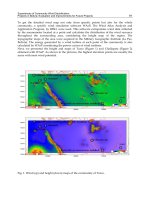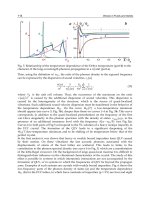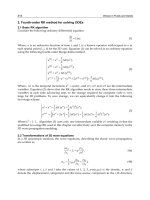Guide for Sound Insulation in Wood Frame Construction Part 6 pdf
Bạn đang xem bản rút gọn của tài liệu. Xem và tải ngay bản đầy đủ của tài liệu tại đây (353.9 KB, 11 trang )
Page 55 of 103
IRC RR-219: Guide for Sound Insulation in Wood Frame Construction March 2006
For all the wall/floor cases studied, the preceding table provides a
representative design estimate of the
change in Apparent-IIC (due to direct
transmission plus flanking paths for all significant walls in the room below) when
toppings are added.
• If all walls in the room below have their gypsum board mounted on
resilient channels, those wall surfaces will not contribute significantly to
the flanking. This yields the best case, with only direct transmission
through the floor, given in the top row of the table.
Note that resilient channels must be mounted between the studs and the
gypsum board, not between two layers of gypsum board.
• With the gypsum board attached directly to the wall studs in the room
below, the Apparent-IIC will be considerably lower. The change due to a
topping is almost identical whether the wall has a double layer of gypsum
board or a single layer, so one row of the table presents the change
expected for both cases.
For intermediate situations where walls are a mix of these cases, a weighted
linear average should be used. As an example consider the case with bare OSB
topping, when the gypsum board of one wall in the lower room is on resilient
channels, two walls have 2 layers directly attached to the studs, and the fourth
wall has a single layer directly attached gypsum board, the weighted linear
average of the values for the “Better Floor” would be
[((53+2)+2x(48+1)+(46+1))/4], giving Apparent-IIC 50.
Summary – Changes to Control Vertical Flanking
(One apartment above another, Impact sound source)
For footstep noise in the case where one
apartment is above the other (vertical
transmission):
1. The flanking path is from the floor
of the room above to the walls of
the room below.
2. The two surfaces that can be
modified to reduce flanking
transmission are the walls below
and the floor surface above.
3. The effects of specific changes to
the walls and floor surface are
listed in the table above.
Airborne
Sound
Source
Direct
Transmission
through floor
Airborne
Sound
Source
Direct
Transmission
through floor
Page 56 of 103
IRC RR-219: Guide for Sound Insulation in Wood Frame Construction March 2006
Horizontal Flanking in Wood-framed Constructions
(One apartment
beside the other, Impact sound source)
For the case of two apartments horizontally separated by a partition wall
assembly, there are four key issues:
Flanking Transmission
via floor surfaces
(Ceiling surfaces isolated)
Flanking Transmission
via wall surfaces
Impact
Sound
Source
Flanking Transmission
via floor surfaces
(Ceiling surfaces isolated)
Flanking Transmission
via wall surfaces
Impact
Sound
Source
1. The flanking paths for impact sound are from the floor of the room
where the impact occurs to the floor and the surface of the separating
wall in the room beside.
2. If the impact source moves closer to the separating wall/floor junction,
the Apparent-IIC decreases. (important for corridors)
3. Apparent-IIC is changed by a flooring surface, such as vinyl flooring
or carpet, but the improvement depends on the underlying floor.
4. Apparent-IIC is affected by details of the floor assembly, the wall
assembly, and the continuity of structural elements across the
floor/wall junction.
In all these cases, the horizontally transmitted impact sound is entirely due
to structure-borne flanking transmission.
Note that the above summary assumes that other horizontal paths are not
significant. Flanking involving sidewalls (i.e., floor-sidewall path) is relatively
unimportant compared to the floor-floor path and in most situations can be safely
ignored. Floor-ceiling paths will be relatively unimportant if there are resilient
channels supporting the gypsum board ceiling, which is designated as
“apartment” construction in this Guide.
Several “row housing” cases, where the ceiling is not on resilient channels, are
presented in a later section.
Some of the above issues assume different significance when considering design
for a room adjacent to a corridor, as opposed to two side-by-side rooms with
similar use. In particular, a corridor will typically involve impacts close to the
separating wall (1 m is used as representative), whereas a distance of 2 m is
more appropriate for a typical room. Hence, two representative distances are
used in this section.
To highlight the key factors influencing flanking across floor/wall systems, a
number of typical configurations are presented, proceeding from cases where the
flanking effect is rather small to cases where flanking causes rather poor sound
insulation.
Page 57 of 103
IRC RR-219: Guide for Sound Insulation in Wood Frame Construction March 2006
With the subfloor continuous across the junction at a double stud wall, Apparent-
IIC is low enough to be a problem, especially if the source is close to the
separating wall.
Link to Corresponding Airborne
Floor joists parallel
to separating wall
(non-loadbearing wall)
50 (bare)
51 (vinyl)
68 (carpet)
Apparent-IIC
Floor joists parallel
to separating wall
(non-loadbearing wall)
50 (bare)
51 (vinyl)
68 (carpet)
Apparent-IIC
50 (bare)
51 (vinyl)
68 (carpet)
Apparent-IIC
The Apparent-IIC may be changed by specific changes in the floor assembly, the
floor/wall junction, or the wall assembly.
Flooring Finish
Bare Vinyl Carpet
Change in Construction Effect
Apparent-IIC (Impact at 2 m)
Changing Floor
16 mm OSB subfloor
⇒ plywood
or wood joists
⇒ wood-I joists
not significant 49—51 50—51 65—68
Changing Floor/Wall Junction
Subfloor break at wall cavity
Depends
on fire block
55 56 75
Changing Wall
Double gypsum board and
insulation on both sides
Depends
on fire block
52 52 70
For Corridors (impact source 1 m from wall): No data for quantitative values,
but qualitatively expect lower Apparent-IIC, as with joists parallel to single stud
wall. (See following cases).
Some of the changes listed in the table are inter-dependent. The effects of these
combined flanking paths are presented on the following page, for some typical
generic fire blocks.
Page 58 of 103
IRC RR-219: Guide for Sound Insulation in Wood Frame Construction March 2006
As noted in the corresponding section on airborne sound, fire blocks are required
to stop the spread of fire through concealed cavities such as that between the
two rows of studs in the wall illustrated above. The performance of such systems
is discussed in an IRC/NRC publication [
3]. As noted in that publication, as well
as performing their intended function of controlling fire, these treatments at the
floor/wall junction can significantly worsen flanking transmission.
The effect of fire blocks depends on the associated constructions. Two
separating walls are considered – basic (as shown above in the figure), and a
better wall (with double gypsum board on each side, and cavity insulation on
each side).
Separating wall Basic Wall Better Wall
Floor covering
Bare Vinyl Carpet Bare Vinyl Carpet
Fire Block
Alternatives
Apparent-IIC (Impact at 2 m)
Continuous OSB or
Plywood
51 51 68 52 52 70
None, or fibrous
material
66 66 82
The tabulated values show that the Apparent-IIC increases as the magnitude of
structural coupling introduced by the fire block decreases. To attain Apparent-IIC
55 or better with the basic OSB subfloor (strongly coupled), it will be necessary to
have a very compliant floor covering, like carpet.
The table also shows that depending on the fire block there may be a significant
benefit to increasing the number of layers of gypsum board of the separating wall
in the receiving room. If this gypsum board were mounted on resilient channels
then a greater improvement might be expected.
In practice, a fire block formed by continuous OSB or plywood subfloor may be
required to provide structural support, especially in regions where strong lateral
loading from winds or seismic activity is expected.
For row housing this may be a lesser concern. The fibrous fire blocks
that cause negligible flanking transmission across the cavity of the
separating double stud wall offer an effective solution in those cases.
Continuous OSB or plywood subfloor is the typical solution for multi-storey
apartment construction. In such cases, the use of a topping may be required,
and this is addressed in later sections.
Page 59 of 103
IRC RR-219: Guide for Sound Insulation in Wood Frame Construction March 2006
With the subfloor continuous across the junction at a double stud wall, and floor
joists parallel to the wall, the Apparent-IIC is slightly better, especially with carpet
applied over the OSB subfloor.
Link to Corresponding Airborne
Floor joists
perpendicular to
separating wall
(loadbearing wall)
51 (bare)
52 (vinyl)
68 (carpet)
Apparent-IIC
Floor joists
perpendicular to
separating wall
(loadbearing wall)
Floor joists
perpendicular to
separating wall
(loadbearing wall)
51 (bare)
52 (vinyl)
68 (carpet)
Apparent-IIC
51 (bare)
52 (vinyl)
68 (carpet)
Apparent-IIC
The Apparent-IIC may be changed by specific changes in the floor assembly, the
floor/wall junction, or the wall assembly.
Flooring Finish
Bare Vinyl Carpet
Change in Construction Effect
Apparent-IIC (Impact at 2 m)
Changing Floor
16 mm OSB subfloor
⇒ plywood
not significant 50—52 51—53 65—68
Changing Floor/Wall Junction
Subfloor break at wall cavity
depends
on fire block
50—61 51—61 65—67
Changing Wall
Double gypsum board and
insulation on both sides
depends
on fire block
51—66 52—66 71—79
For Corridors (impact source 1 m from wall): No data for quantitative values,
but qualitatively expect lower Apparent-IIC as with joists perpendicular to single
stud wall. (See following cases).
Some of the changes listed in the table are inter-dependent. The effects of these
combined flanking paths are presented on the following page, for some typical
generic fire blocks.
Page 60 of 103
IRC RR-219: Guide for Sound Insulation in Wood Frame Construction March 2006
The effect of fire blocks depends on the associated constructions. Two
separating walls are considered – basic (as shown above in the figure), and a
better wall (with double gypsum board on each side, and cavity insulation on
each side).
Separating wall Basic Wall Better Wall
Floor covering
Bare Vinyl Carpet Bare Vinyl Carpet
Fire Block
Alternatives
Apparent-IIC (Impact at 2 m)
Continuous OSB or
Plywood
50 51 65 51 52 71
Coreboard (between
joist headers)
52 52 65 57 57 73
0.38 mm sheet steel 54 55 68 55 56 71
Fibrous material (glass
fibre or rock fibre of
suitable density)
61 61 67 66 66 79
No material in gap
N/A N/A N/A 66 66 79
The performance of fire blocks (for both sound and fire) is addressed further in
References 3 and
4.
The tabulated values show that the Apparent-IIC increases as the structural
coupling introduced by the fire block decreases. To attain Apparent-IIC 55 or
better with the basic OSB subfloor (strongly coupled), it will be necessary to have
a very compliant floor covering, like carpet.
The table also shows that depending on the fire block there may be a significant
benefit to increasing the number of layers of gypsum board of the separating wall
in the receiving room. If this gypsum board were mounted on resilient channels
then a greater improvement might be expected.
Page 61 of 103
IRC RR-219: Guide for Sound Insulation in Wood Frame Construction March 2006
With the floor joists parallel to the separating wall, changing from the double stud
wall to a simpler single stud wall assembly permits more transfer of structural
vibration across the junction, and hence lowers Apparent-IIC for the bare floor to
49 for impacts 2m from the wall.
Link to Corresponding Airborne
Alternate
junction
details
Floor joists parallel
to separating wall
(non-loadbearing wall)
Apparent-IIC
49 (bare)
49 (vinyl)
66 (carpet)
Alternate
junction
details
Floor joists parallel
to separating wall
(non-loadbearing wall)
Alternate
junction
details
Floor joists parallel
to separating wall
(non-loadbearing wall)
Apparent-IIC
49 (bare)
49 (vinyl)
66 (carpet)
Apparent-IIC
49 (bare)
49 (vinyl)
66 (carpet)
Changing the fire blocking detail at the junction has little effect on the Apparent-
IIC. Changing the wall surface facing the receiver has some effect.
Altering the layers of gypsum board on the receiving room side of the separating
wall (or how they are attached) significantly changes Apparent-IIC
Flooring Finish
Bare Vinyl Carpet
Change in Construction Effect
Apparent-IIC (Impact at 2 m)
Changing Floor/Wall Junction
Subfloor break under wall or
alternate junction details shown
not
significant
49 49 66
Wall (receiving room side)
Gypsum board alternatives -
direct-attached, 1 layer
direct-attached, 2 layers
on resilient channels, 1 layer
Improves
48
49
51
48
49
52
66
66
71
For Corridors (impact source 1 m from wall)
expect change in Apparent IIC
-6 -5 -3
Page 62 of 103
IRC RR-219: Guide for Sound Insulation in Wood Frame Construction March 2006
With the single stud wall assembly, changing orientation of the floor joists (from
parallel to the separating wall to perpendicular) transmits more structural
vibration across the floor and alters the junction. This lowers Apparent-IIC for the
bare floor to 42 for impacts 2m from the wall.
Link to Corresponding Airborne
Floor joists
perpendicular to
separating wall
(loadbearing wall)
Apparent-IIC
42 (bare)
43 (vinyl)
63 (carpet)
Floor joists
perpendicular to
separating wall
(loadbearing wall)
Floor joists
perpendicular to
separating wall
(loadbearing wall)
Apparent-IIC
42 (bare)
43 (vinyl)
63 (carpet)
Apparent-IIC
42 (bare)
43 (vinyl)
63 (carpet)
Cutting the subfloor at the junction has little effect on the Apparent-IIC.
Changing the wall surface facing the receiver has some effect (but less than with
the joists parallel, because the floor-floor path is more dominant).
Flooring Finish
Bare Vinyl Carpet
Change in Construction Effect
Apparent-IIC (Impact at 2 m)
Changing Floor/Wall Junction
Subfloor break under wall
not
significant
42 43 63
Wall (receiving room side)
Gypsum board alternatives -
direct-attached, 1 layer
direct-attached, 2 layers
on resilient channels, 1 layer
Improves
slightly
41
42
43
42
43
44
63
63
65
For Corridors (impact source 1 m from wall)
expect change in Apparent IIC
-4 -3 -1
Page 63 of 103
IRC RR-219: Guide for Sound Insulation in Wood Frame Construction March 2006
With subfloor and joists
both continuous across the floor/wall junction, but the
same single stud wall and floor details, there is more transfer of structural
vibration across the junction. This lowers Apparent-IIC for the bare floor to 38 for
impacts 2m from the wall.
Link to Corresponding Airborne
Floor joists continuous
and perpendicular to
separating wall
(loadbearing wall)
Apparent-IIC
38 (bare)
38 (vinyl)
58 (carpet)
Floor joists continuous
and perpendicular to
separating wall
(loadbearing wall)
Floor joists continuous
and perpendicular to
separating wall
(loadbearing wall)
Floor joists continuous
and perpendicular to
separating wall
(loadbearing wall)
Apparent-IIC
38 (bare)
38 (vinyl)
58 (carpet)
Apparent-IIC
38 (bare)
38 (vinyl)
58 (carpet)
Cutting the subfloor under the wall at the junction, has little effect on the
Apparent-IIC.
Changing the wall surface facing the receiver has negligible effect, because the
floor-floor path is dominant. (See table).
Flooring Finish
Bare Vinyl Carpet
Change in Construction Effect
Apparent-IIC (Impact at 2 m)
Changing Floor/Wall Junction
Subfloor break under wall at
floor/wall junction
not
significant
38 38 58
Changing Wall
Gypsum board on receiving
room side on resilient channels
not
significant
38 39 59
For Corridors (impact source 1 m from wall)
expect change in Apparent IIC
-3 -3 0
Page 64 of 103
IRC RR-219: Guide for Sound Insulation in Wood Frame Construction March 2006
Summary – Horizontal Flanking in Typical Constructions
(One apartment beside the other, Impact sound source)
For the case of two apartments horizontally separated by a partition wall
assembly, or beside a corridor, the Apparent-IIC is entirely due to flanking
transmission.
Flanking Transmission
via floor surfaces
(Ceiling surfaces isolated)
Flanking Transmission
via wall surfaces
Impact
Sound
Source
Flanking Transmission
via floor surfaces
(Ceiling surfaces isolated)
Flanking Transmission
via wall surfaces
Impact
Sound
Source
There are three main issues:
1. When the floor assembly has a basic OSB or plywood subfloor, the
main flanking path is consistently from the floor of one room to the
floor of the other, although the wall of the receiving room also
contributes in some cases.
2. Apparent-IIC is strongly affected by joist orientation and the continuity
of floor components across the floor/wall junction.
3. Because vibration is attenuated across the floor assembly, as it
spreads away from the source, the Apparent-IIC is lower when the
impact occurs near the separating wall (as it would for corridors).
Page 65 of 103
IRC RR-219: Guide for Sound Insulation in Wood Frame Construction March 2006
Changes to Control Horizontal Flanking
(One apartment
beside another, Impact sound source)
For footstep noise in the case of apartments horizontally separated by a
partition wall assembly, or beside a corridor (horizontal transmission), the
Apparent-IIC is entirely due to flanking transmission.
Flanking Transmission
via floor surfaces
(Ceiling surfaces isolated)
Flanking Transmission
via wall surfaces
Impact
Sound
Source
Flanking Transmission
via floor surfaces
(Ceiling surfaces isolated)
Flanking Transmission
via wall surfaces
Impact
Sound
Source
1. The main flanking path is consistently from the floor of one room to
the floor of the room beside, if the basic floor surface is a layer of
oriented strand board (OSB) or of plywood directly fastened to the
top of the floor joists.
2. To significantly reduce flanking transmission, the key surfaces to
modify are the floors in the two rooms.
3. The incremental effect of adding a floor topping depends not just on
the topping but also on the floor over which it is applied. In particular,
the improvement due to a topping depends strongly on the orientation
of the floor joists relative to the floor/wall junction.
4. The improvement depends on whether the impacts are close to the
separating wall (corridor vs. adjacent apartment)
5. In some cases, the change in the floor-floor flanking transmission is
substantial, and coupled with improvements to the wall itself may
provide a very high Apparent-IIC.
Note that data and analysis in this section are all for the case with resilient
channels supporting the ceiling, which is assumed to be characteristic for
“apartment” construction – the focus of this section.
“Row housing” cases, where the ceiling is not on resilient channels, are
presented in the following section. These constructions exhibit similar horizontal
flanking to the cases in this section; apparently attachment of the ceiling only
weakly affects flanking transmission across the floor. However, on the diagonal,
the effect of flanking transmission via the direct-applied ceiling becomes evident
in row housing.
Because the effect of toppings depends quite strongly on the supporting floor
assembly, the effect is shown for each of the basic floor assemblies in turn, in the
same order as the preceding section presenting performance with the basic
subfloor.









